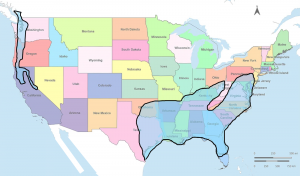There is a new pest in the US – the yellow-legged hornet Vespa velutina. It is a hawker. Last month when I travelled to Georgia to assist with their Master Beekeeper training and speak at the Georgia fall statewide bee meeting, this new pest was the hot topic.
New Discovery
On August 9 a beekeeper near the port city of Savannah, GA reported 2 individuals of what he believed were wasps eating numbers of bees in front of his colony. Positive ID was confirmed (Aug 15th) for Vespa velutina (YLH), the first time this bee pest was found in the US. After an intense search, a nest of this wasp was discovered very high in a tree. It could not be removed so it was destroyed with a strong stream of water on August 25th.
The yellow-legged hornet is a social wasp species that constructs typical hornet paper nests above ground, concealed in vegetation. Nest populations can become large, housing over a thousand workers. It is a voracious predator of insects; bees and other wasps are their favorite food.
It is brand new pest to the US. The yellow-legged hornet is native to tropical and subtropical areas of Southeast Asia. It has invaded Korea and Japan and Europe, (introduced into France and since spread to Portugal, northern Spain, southern England and spreading into Belgium and Italy) see MDPI Journal Diversity: https://www.mdpi.com/1424-2818/12/1/5 Gard Otis has an excellent review in October Bee Culture [shown here] https://www.beeculture.com/yellow-legged-hornet-in-north-america/
A second nest was found in early September in the same general area as the first nest. It was captured intact and not destroyed. The developing nest population was carefully examined for the development of reproductives. Like other seasonally social bees and wasps, a single female starts a nest then rears a population of sterile workers. At the end of their season the males and female reproductives are raised. The good news is that no reproductives were found in this second nest; it was captured before the wasps produced their reproductives.
It is believed these two nests resulted from one nest established the year before. The USDA APHIS is seeking to discover how closely related the workers from the 2 nests found so far are related to answer that question. A study in Europe pointed out that to eradicate a new arrival, the first 2 years following introduction are critical.
All was not good news about this new pest. The DNA evidence suggests the introduction came from Asia, not Europe, meaning it could also have come to our shores. An analysis of weather features where it currently exists in Asia and Europe was downright bad news. If established the yellow legged wasp should find suitable habitat in the Southeastern US PLUS the Pacific northwest. See Bee Culture magazine for a map of where it might establish in the US.
Hawking
The yellow-legged hornet represents a novel means of how a pest might exploit honey bees. The adult wasps hawk in front of active colonies. They communicate the source of the bee colony to nest mates and then join together as a flying curtain just before the bee nest entrance to pick slower-flying, heavily laiden returning honey bee foragers out of the air. They capture bees on the wing, cut off parts they do not want and fly back to their nest with head (or thorax). They can further weaken weak colonies and cause forager paralysis at the entrance. Their presence effectively halts incoming and exiting by the honey bees. They do not enter or land on bee hives, nor scavenge dead/dying foragers like our yellowjackets.
We can use the behavior of hawking as a means of determining if and where there are nests. Individuals hawking honey bees can be captured, fed and then observed as they fly off towards their nest. By capturing individuals from the same nest at 2 or more locations and timing the length of time it takes for marked wasps to return, it is possible to narrow the search area of the nest itself. Nests so far have been very high in trees.
Authorities in Georgia are also using trapping technology developed from studies to find and eliminate nests of the Asian Giant Hornet in Washington. Radio tracking after attaching tiny antennae to captured wasps is one such technique. They are also using radar to track flight patterns. Dr Jamie Ellis of Florida is utilizing iDNA technology to identify where wasps have been feeding on favorite protein foods such as fish to determine relatedness of wasp visitors as a way of estimating the number of nests that might occur in an area.
From their experience in Georgia, it is clear we need to be vigilant to keep this hawking hornet out of Oregon and the Pacific Northwest. Beekeepers in Georgia were the first to sound the alarm of the introduction. OSU bee lab or ODA personnel are anxious to hear from you if you notice wasp hawking in your apiary.
Key ID characteristics are size (2cm long= ¾ inch), yellow color on 4th abdominal segment and lower tarsal portions of legs (especially hind legs) distinctly yellow. For photo gallery see https://bees.caes.uga.edu/bees-beekeeping-pollination/yellow-legged-hornet.html.html

